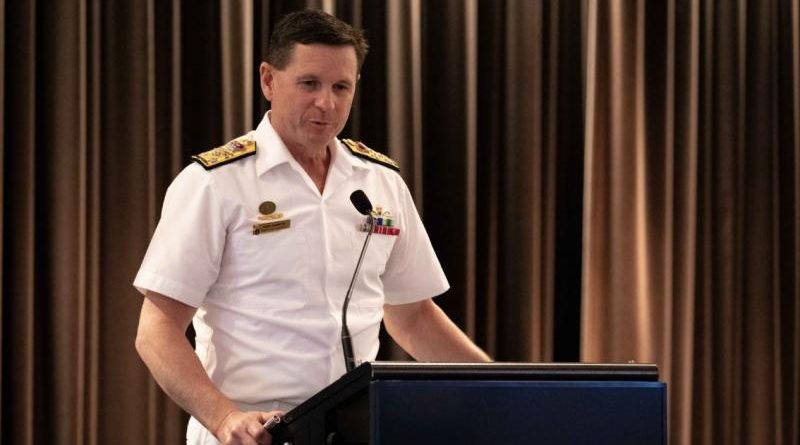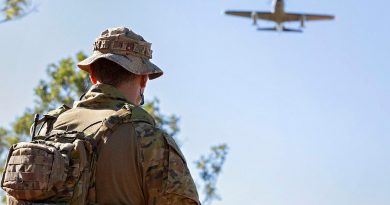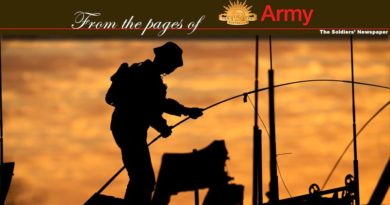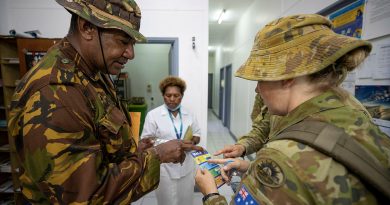Leaders discuss future of nuclear-powered subs
Share the post "Leaders discuss future of nuclear-powered subs"

Opportunities and challenges involved in Australia’s acquisition of nuclear-powered submarines were discussed at the 11th biennial Submarine Institute of Australia conference hosted in Canberra in November.
CAPTION: Chief of Navy Vice Admiral Mark Hammond speaks at the 11th Biennial Submarine Institute of Australia Conference hosted in in Canberra. Photo by Nic Douglass.
Opening the conference, Minister for Defence Richard Marles said it was important to explain why submarines were a key component of Australia’s strategic and defence capability requirements.
“Continuing to promote discussion about this capability, its place within the broader defence capabilities and the role it has building Australia’s strategic space is vitally important,” Mr Marles said.
“Submarines are pretty mysterious to be honest. For the broader public – what they do, why they matter, is not clear.”
Mr Marles said nuclear-powered submarines would be an essential part of Australia’s naval and defence capability, as it faced the most complex and challenging strategic settings since the end of World War 2.
)
CAPTION:Minister for Defence Richard Marles, left, in conversation with Submarine Institute of Australia president Michael Fitzgerald at the conference. Photo by Nic Douglass.
“By virtue of their stealth and the unique capabilities, submarines can place the single biggest question mark in our adversaries’ mind,” Mr Marles said.
Mr Marles also highlighted the enormous benefit nuclear-powered submarines provided, not only in terms of jobs and an increased workforce, but in relation to Australia’s investment in science and technology.
Chief of Navy Vice Admiral Mark Hammond said that as an island nation, Australia was completely reliant on maritime trade and the seabed cables for its national wellbeing and connectivity with the outside world.
“Sea lines of communication are the lifeblood of this nation, and in that context the Navy and its submarine capability is imperative,” Vice Admiral Hammond said.
“To that point, our next generation of submarines do offer an impactful power projection capability that can not only mitigate threats to our supply chain, threats to the lifeblood for the Australian economy, and they can also represent a risk to the adversary’s supply chain and national wellbeing.
“Our economic wellbeing, our national wellbeing is dependent upon the sea. Nuclear-powered submarines represent a truly unique, lethal power projection capability that forms a question mark in our adversary’s minds. If we do our job right, the deterrence and inherent lethality of this capability will be enough for decades to come.”
Head of Capability Nuclear-Powered Submarine Task Force Rear Admiral Matt Buckley said the AUKUS partnership would enable Australia to build the rigorous levels of stewardship required to deliver a safe and secure sovereign nuclear-powered submarine capability.
“The optimal pathway is more than just the design of the next-generation Australian submarine. We are developing much more than a submarine,” Rear Admiral Buckley said.
“Nuclear stewardship is a combination of elements to safely and securely safeguard this technology. It is one of the greatest challenges, yet opportunity, for this whole-of-nation endeavour. There are no shortcuts. Once the bar is set, there is no deferring from that exemplar level.”
UK Defence MinistryDirector Nuclear Technology Rear Admiral Tim Hodgson discussed the journey the United Kingdom undertook transforming its submarine fleet from diesel to nuclear technology, and having both technologies work alongside each other.
Rear Admiral Hodgson said the United Kingdom encountered numerous challenges across organisation structure, training, infrastructure, supply chain and enterprise elements.
He said Australia had a head start on these challenges under the AUKUS partnership, being able to learn from the lessons when transforming the submarine fleet.
Rear Admiral Hodgson’s advice was to “make the best decisions based on the program needs rather than on the individual needs of each of the organisations involved. Having that clarity will help drive this national endeavour”.
United States Navy Commander Submarine Group Seven Rear Admiral Richard Seif said AUKUS provided a true interchangeability of undersea forces, seamlessly interconnecting nations’ navies to be an overwhelming applied deterrent and, if required, a lethal force.
“In peacetime they stand the watch, holding targets at risk, and creating doubt and a credible deterrent against any aggressor. You cannot have effective deterrence without submarines,” Rear Admiral Seif said.
“The goal of AUKUS is to bolster deterrence and stability in the Indo-Pacific region. However, should deterrence fail, we must be ready to fight alongside each other, interchangeable and seamlessly integrated, appearing at the time of our choosing ready to unleash overwhelming, devastating firepower on any adversary.”
)
CAPTION: From left, Head of Capability Nuclear Powered Submarine Task force Rear Admiral Matt Buckley, UK Defence Ministry Director Nuclear Technology Rear Admiral Tim Hodgson, United States Navy Commander Submarine Group Seven Rear Admiral Richard Seif and Director General Submarines Commodore Tom Phillips at the conference. Photo by Nic Douglass.
For more information about Australia’s acquisition of nuclear-powered submarines, visit www.defence.gov.au/NPSTF.
.
.

.
.
Share the post "Leaders discuss future of nuclear-powered subs"





